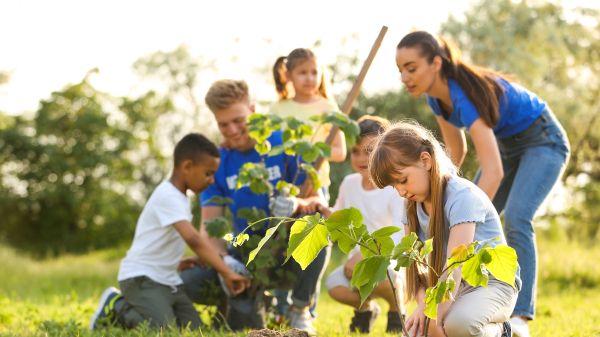President's Environmental Youth Award (PEYA)

Since 1971, the President of the United States has joined with EPA to recognize young people for protecting our nation's air, water, land, and ecology. Each year the PEYA program honors a wide variety of projects developed by young students, school classes and clubs, youth camps, and youth organizations to promote environmental awareness and action in schools and communities.
Your student's project could be an award winner! PEYA applicants compete in two award categories— Grades K–5 and Grades 6–12—each with distinct evaluation criteria. Applicants from all 50 states as well as U.S. territories are eligible to compete for the national Presidential award. Encourage your students with an existing environmental stewardship project or an idea for a project to apply so that their achievements can be further recognized.
How to Apply for the PEYA National Award Program
Step 1: Confirm Competition Eligibility
- Project is completed while the applicant(s) is in kindergarten through 12th grade.
- Applicant(s) is a citizen of the United States or its territories or has been lawfully admitted for permanent residency. Applicant also resides in a U.S. state, territory, or tribal land.
- Project is sponsored by at least one adult 21 years of age or older. See below for more information regarding sponsors.
- Project started during the 2024 calendar year and had activity during the 2024 calendar year. A project initiated prior to 2024 is also eligible for consideration as long as the project had activity during the 2024 calendar year.
- Project must include an environmental stewardship component as defined below.
Step 2: How to Apply
Application period is OPEN from October 15, 2024 to January 15, 2025.
Each applicant or team of applicants applying for PEYA must be represented by at least one sponsor who submits the application to EPA and serves as EPA’s point of contact for the application. The application form and all application materials should be typed, but there are no defined font or spacing requirements as long as materials are legible.
- DOWNLOAD THE APPLICATION: Download the PEYA Application Guide (pdf) (494.41 KB) and PEYA Application Form (pdf) (347.93 KB) .
- CONFIRM ELIGIBILITY: Applicant sponsor/co-sponsor confirms that applicants meet all eligibility requirements by completing the Eligibility Self-Screen Checklist located in the application guide.
- PREPARE APPLICATION FORM: Applicant sponsor/co-sponsor completes pages 1–4 of the PEYA Application Form. Applicant sponsor/co-sponsor supports grade 6–12 applicants by gathering project information written by the applicants. Applicant sponsor/co-sponsor supports grade K–5 applicants by helping the applicants to write and gather project information. Excess pages submitted beyond the limits stated below will not be considered. Carefully consider inclusion of web links that clearly support the project description and/or supplementary information in conveying how the project achieved applicable review criteria as reviewers will not click on more than 5–6 web links per application. Note also that we cannot accept links to file share drives or social media accounts.
- PROJECT TITLE: Identify the name of the project title on the Application Form. Please ensure that the project title is accurate as the project title will be used in program materials, including plaques, certificates, and letters of acknowledgement. The project title cannot be changed after application submission.
- APPLICANTS BY NAME AND GRADE LEVEL: The sponsor/co-sponsor(s) are responsible for identifying the name and grade level of each applicant. It is very important that the applicant names are accurate as the names provided on the application form will be inscribed on all materials, including certificates, letters of acknowledgement award plaques, and in program materials. Applicant names cannot be changed after application submission.
- PROJECT SUMMARY: The Project Summary, up to 300 words, is intended to describe the project’s purpose and goals and identify the results achieved. Space for the Project Summary is provided on page 4 of the Application Form.
- DETAILED PROJECT DESCRIPTION: Grade 6–12 applicants are required to provide a more detailed description of the project preferably organized by each of the evaluation criteria in Section 6: How Applicants are Judged. Grade K–5 applicants are encouraged to have written, with the assistance of the sponsor/co-sponsor(s), a description of the project. The Project Description must be no more than 5 pages or 5 slides.
- SUPPORTING MATERIALS: Applicants may submit up to 5 additional pages of optional supporting materials; for example, photographs, newspaper articles, or other information to provide a more comprehensive view of the project. Accompanying videos may be submitted, although applicants must provide a web link to where the videos can be viewed online. Please DO NOT send video files by email; video files sent by email will not be reviewed.
- SIGN AND DATE APPLICATION: Sponsor/co-sponsor must sign and date page 4 of the PEYA Application Form. Signatures must be electronic; typing in the sponsor’s name does not fulfill the application requirements. Page 4 of the PEYA Application Form can be submitted as a separate file if needed.
- COLLECT PARENT-SIGNED FORMS: Sponsor/co-sponsor collects signed and dated Consent for PEYA Student Works Forms and the PEYA Permission Form from each applicant’s parent/guardian. Please review the forms carefully to ensure that signatures by the parent/adult are electronic. Typing in the parent/adult’s name does not fulfill the application requirements.
- COMPLETE THE PRE-SUBMISSION CHECKLIST: Sponsor/co-sponsor completes the pre-submission checklist.
- SUBMIT THE APPLICATION BY JANUARY 15, 2025: See instructions below for submitting an application.
Step 3: Submit the Application
- To protect the online privacy of student applicants, applicant sponsor/co-sponsor gathers and submits application materials.
- Application materials are submitted electronically (email) by sponsors.
Project Sponsors
Each applicant or group of applicants applying for PEYA must be represented by at least one sponsor who is a teacher or other education professional. An exception to this rule can be made for home-schooled applicants with no interaction with formal educators or youth development clubs, in which case the teacher sponsor can be a parent.
Judging Criteria
Applications determined eligible and complete are evaluated by a PEYA awards panel. The panel members review and evaluate each application based on the criteria. There are separate evaluation criteria for K–5 and 6–12 applications.
Evaluation criteria for PEYA applications from K–5th grade students
- Youth Driven Initiative
- Environmental Stewardship* and Impact
- Achieving Project Goals
- Community Involvement
- Project Creativity and/or Innovation
- Project Approach
Evaluation criteria for PEYA applications from 6th–12th grade students
- Youth Driven Initiative
- Environmental Need and Appropriateness
- Environmental Stewardship* and Impact
- Achieving Project Goals
- Community Involvement
- Project Creativity and/or Innovation
- Soundness of Approach, Rationale and Scientific Design
*Definition: “Environmental Stewardship” is voluntary commitment, behavior, and action that results in environmental protection or improvement, or conservation of our natural resources. Stewardship refers to an acceptance of personal responsibility for actions to improve environmental quality and to achieve conservation outcomes. Stewardship involves lifestyles and business practices, initiatives and actions that enhance the state of the environment and natural resources. Some examples are:
- living or conducting business in such a way as to minimize or eliminate pollution at its source;
- using natural resources efficiently;
- decreasing the use of hazardous chemicals;
- recycling wastes effectively; and
- conserving or restoring soil, forests, prairies, wetlands, rivers, and parks.
Stewardship can be practiced by individuals, groups, schools, organizations, companies, communities, and state and local governments.
Recognition of Winners
Each year, EPA gives a Presidential plaque to the national award winners. Awardees will also be invited to a ceremony in which the awards are distributed to the winning projects.
Read about current and past PEYA winners.
Further information can be found on the PEYA website: President's Environmental Youth Award | US EPA
Please contact the PEYA program manager Chelsea McClure (PEYA@epa.gov) with additional questions.
Please note: Sponsors/co-sponsors are responsible for managing all correspondence with EPA including application submission, submitting questions, and all other communication. To protect the online privacy of student applicants, EPA will not respond to inquiries submitted by student applicants. All communications must be sent by the adult sponsors/co-sponsors

